Xi’s old time in Fuzhou: The people-centered ‘3820’ project

In 1992, Xi Jinping, then secretary of the Communist Party of China Fuzhou Municipal Committee in Fujian Province, laid out the plan of three-, eight- and 20-year economic and social development of Fuzhou.
Called the “3820,” the strategic project has covered areas including urban construction, environmental protection, culture, education, in which the people-centered development idea was well presented.
‘Treating masses’ issues as a big deal’
In the early 1990s, along the Minjiang River, three generations of Zheng Hejian’s family lived crammed in a small wooden boat.
In March 1991, Xi, already chief of the Party Fuzhou municipal committee, discovered this situation during his field research and immediately convened an on-site meeting to study how to solve it.
According to Zheng, resettling those living in thatched sheds and small boats was immediately included in the local practical projects to improve local livelihoods. “It took only 10 months for 104 households of boat people to move into Red Star New Village,” said Zheng.
The life-changing story of Zheng and these boat people is a vivid example how the “3820” strategic project was implemented.
Xi has repeatedly called on Party comrades to care about the masses’ warmth and security, stressing that the masses’ issues should be treated as a big deal.
“Closing contact between the Party and the masses enables Party organizations and governments at all levels to gain timely insights into some problems and to make investigations and research through this channel of contacting the masses. Moreover, we can promptly solve some practical problems among the masses and resolve some difficult and hot issues,” Xi said in 1995 during an interview.
‘People’s business is my business’
Housing, related to the vital interests of thousands of families, is both a livelihood issue and a development issue, which runs through the whole process of the implementation of the “3820” strategic project.
Xi’s three visits to Cangxia community in Fuzhou is a well-known story for the locals.
As a typical shantytown, this place was once dilapidated and chaotic. On July 2, 2000, Xi who was already the governor of Fujian Province at that time, led officials from major functional departments to Cangxia to conduct research.
“Xi came to my house. Our house was a stuffy can, it’s hot, so hot. He came down on a hot day to do research, stay close to the people, and he said the people’s business is his business,” Tang Qingwang, a resident who has experienced Cangxia’s shed reform, said.
“After staying for a while, everyone was sweating. At that time Xi spoke up, ‘Have you ever lived in this kind of environment? If you are told to live there, will you live here or not? Currently our people still live in this kind of environment, don’t you think we should rebuild it?'” Yang Muze, then director of the government office in Taijiang District, Fuzhou, recalled.
On the same day, Xi also held a symposium with representatives of the residents over the rebuilding matters, and he said, “Please convey a message to the people, the government will do a good job.”
Soon after, the Cangxia shantytown started its rebuilding project. During this period, Xi visited Cangxia twice more to promote the rebuilding work. A year later, more than 3,400 residents moved back to their new homes.
‘Economic development cannot sacrifice the environment’
As one of the Chinese cities with the most developed inland water system, Fuzhou, in the early 1990s, was affected by the direct discharge of industrial and domestic sewage, causing serious pollution in the inland water.
However, there was no idea on how to deal with the relationship between economic development and environmental protection as economy was the main focus at that time.
“Efforts must be made to promote the coordinated development of economy and environment,” Xi pointed out during the city’s third environmental protection work conference, adding that any behavior that sacrifices the environment for temporary economic benefits is not worth the gain.
Though Fuzhou’s fiscal budget was only slightly over 1 billion yuan (about $119 million) in 1995, the city’s Party committee and government proposed to spend 300 million yuan to improve the environment of the inland rivers in six years. Yang Xiao, an inspector of the city’s garden center, told CMG, “The intensity is unprecedented.”
Starting from the “3820” strategic project, Fuzhou has made lasting efforts to promote green development. As a result, a total of 107 inland rivers have seen improvement in environment, and the environment of the Minjiang River has also been comprehensively improved.
Today, the city is dotted with more than 1,500 parks, with urban green coverage rate exceeding 43 percent.
Eventually, the people-centered project has brought tangible benefits to the people of Fuzhou.
From 1992 to 2023, the per capita disposable income of urban and rural residents increased from 2,273 yuan and 1,109 yuan to 58,009 yuan and 28,636 yuan.









Comments